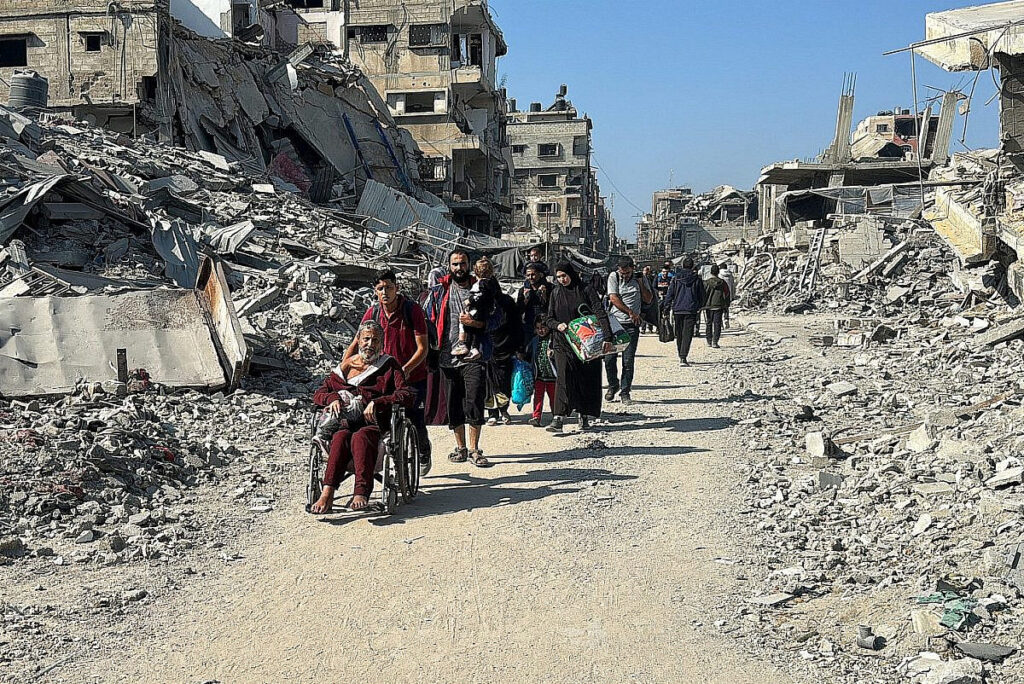The UN estimates that between 65,000 and 75,000 Gazans remain in the besieged cities of Beit Lahiya, Beit Hanoun, and Jabalia. Mahmoud Basal, a civil defense spokesperson, put that number slightly higher: closer to 80,000.
“The situation in northern Gaza, specifically in Beit Lahiya, is extremely catastrophic,” Basal stressed, adding that Israel is dropping large missiles on residential buildings “without prior warning and with residents still inside.” He and his staff, he said, “are working in extremely difficult conditions due to the Israeli targeting of our teams. We have no equipment. We search for those trapped and pull victims from under the rubble using primitive methods.”
Many of the city’s buildings which have not been totally flattened by airstrikes, shelling, drone strikes, and bulldozers have sustained extensive shrapnel damage, making them virtually uninhabitable. Hamouda’s house was completely destroyed by an Israeli attack, forcing him and his family to take shelter in a nearby building which, he said, is “on the verge of collapsing.”
And after severing Gaza’s northern cities from the rest of the Strip, the military is preventing any food or medical supplies from entering. “My family and I are now drinking unclean water, and eating the last remaining cans of legumes,” Hamouda told +972.
Yet despite the dire conditions and the constant Israeli warnings ordering residents to evacuate southward in the direction of Gaza City, Hamouda and his family are determined not to leave. “There is no safe place anywhere in Gaza,” he said. “All residents are at risk of being bombed and killed at any moment.”
‘I saw men and women drowning in their own blood’
Shukri Al-Bodi, a 51-year-old from the neighborhood of Al-Shaima’a in Beit Lahiya, described the situation in the city as a “Nakba in the 21st century.”
“The landmarks have disappeared — it has become a pile of rubble,” he told +972. “My family and I move from place to place, fleeing from the intense shelling.”
According to Al-Bodi, the Israeli army’s relentless attacks on Beit Lahiya have left many residents without any shelter at all. “We are suffering from severe overcrowding,” he explained. “People have spread out onto the sidewalks and the streets, with no basic means of survival in the cold weather.”
“The occupation is demolishing entire residential areas, and people are trapped inside their homes with nothing to eat, terrified of shells falling on them at any moment,” Al-Bodi continued. “Surveillance drones are routinely flying over us at low altitudes, and quadcopter drones are opening fire at groups of civilians to force them to leave the city.”
Nermine Labed, 31, fled Beit Lahiya on foot with her four children on Nov. 17, walking for three hours until reaching the Sheikh Radwan neighborhood in Gaza City. “We made the journey while shells flew over our heads because there is nothing to eat or drink [in Beit Lahiya], and the situation is getting more dangerous by the day,” she told +972.
“While leaving the town, I saw many bodies lying on the ground, and dogs were devouring some of them,” she recounted. “I also saw men and women who were wounded, still alive but drowning in their own blood, with no one to help them. This is not life; we are dying slowly. How much longer will this killing and destruction continue?”
Khaled Al-Omari, 27, arrived in Beit Lahiya on Oct. 14 after fleeing Jabalia refugee camp. He told +972 that the Israeli army’s siege of the city, including “snipers positioned at all of the entrances,” has severely restricted residents’ freedom of movement and left them exceedingly vulnerable. “We are terrified and always wondering when it will be our turn — it seems Israel wants to exterminate us all,” he said.
“The hardest moments I experienced were when I heard the cries of people who were alive under the rubble of their destroyed homes, which were targeted by the occupation,” Al-Omari continued. “They were calling for help, but no one could do anything for them due to the absence of civil defense teams.”
Nevertheless, Al-Omari said, he and many other refugees sheltering in the Beit Lahia Project complex decided to “resist until our last breath, despite the lack of food and water and the repeated Israeli warnings for residents to evacuate the area.”
In a statement to +972, a spokesperson for the Israeli army said that its operations in northern Gaza comply with international law, and that any claims of indiscriminate targeting are “completely baseless.” It further claimed that it was “facilitating and easing the entry of humanitarian aid” into northern Gaza, and allowing for “safer evacuations” by arranging “temporary ceasefires.” The spokesperson accused Hamas of exploiting hospitals for military purposes, which “required the IDF to take action inside hospitals against the militants.” It also claimed that “over 666 aid trucks containing food, water, and more have entered the northern Gaza Strip” since the beginning of October.
_________________________________________

